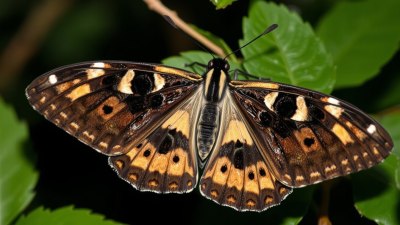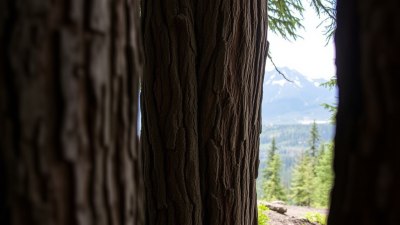Learning to Identify Local Moths and Butterflies at Night Tours
Discover how to identify local moths and butterflies during exciting night tours and enhance your nature experience.

Image created with Flux Schnell
Nighttime in nature reveals a world often overlooked during the day, where moths and butterflies take center stage. With their mesmerizing patterns and nocturnal habits, these fascinating insects can be both beautiful and elusive. Participating in night tours dedicated to identifying local moths and butterflies can transform your understanding of these creatures while fostering a deep appreciation for biodiversity. This article provides a comprehensive guide on how to identify these nocturnal wonders, what to expect on a night tour, and tips for enhancing your experience in the field.
Understanding Moths and Butterflies
Both moths and butterflies belong to the order Lepidoptera, which comprises thousands of species found around the globe. While most people think of butterflies as colorful day-flyers, moths make up a considerable number of this order and are often less appreciated.
Moths generally have a robust body and a fuzzy appearance, displaying muted colors that help them blend into their surroundings. In contrast, butterflies tend to be more delicate with smoother bodies and brighter colors. Their behavior also varies; most butterflies are diurnal, while moths are primarily nocturnal. Understanding these basic differences will help you appreciate their unique beauty during your night tour.
Preparing for a Night Tour
Preparation is key to a successful night tour. Start by researching local organizations or naturalists who offer guided tours focusing on moths and butterflies in your area. Most tours take place in locations with rich biodiversity, such as parks, nature reserves, or botanical gardens, where various species can be observed.
Before attending, gather your materials: a flashlight with a red filter (to minimize disturbance), a notebook for sketching and notes, and your phone or a camera for capturing images. Wear comfortable clothing appropriate for the weather, and don’t forget to bring insect repellent to avoid being bitten by pests.
What to Expect on the Tour
Upon arrival, your guide will likely provide a brief overview of the local ecosystems, the species you may encounter, and safety guidelines. Adventures often start at dusk, just as moths begin to emerge. With your guide’s keen observation skills and insights, you'll spot various species attracted to sources of light or natural plants.
Most night tours encourage active participation, allowing you to explore specific areas where moths congregate. Using UV light can illuminate many species, as moths are attracted to this type of light, resulting in an enchanting spectacle. Your guide may also bring light traps to show you how they attract and gently collect moths for educational purposes.
Identifying Species
Identification of moths and butterflies can initially seem overwhelming, but focusing on key characteristics can simplify the process. When observing, take note of body shape, coloration, patterns, and even flight behavior.
Additionally, learning to identify specific families can enhance your experience. Some common families of moths include the Noctuidae (owlet moths), Sphingidae (hawk moths), and Geometridae (geometer moths). In butterflies, families like Nymphalidae (brush-footed butterflies), Pieridae (whites and sulfurs), and Papilionidae (swallowtails) are notable.
Field guides or mobile applications can help validate your findings. Several apps allow you to compare your observations with collected databases, making identification easier and more engaging.
The Importance of Moths and Butterflies
Understanding and identifying local moths and butterflies has ecological significance. They play vital roles in the ecosystem as pollinators and as part of the food web. Moths and butterflies also serve as indicators of environmental health, alerting us to changes in our ecosystems caused by climate change, habitat loss, or pollution.
Conservation Efforts
Moth and butterfly populations are facing threats due to habitat destruction, climate change, and pesticide use. By participating in night tours, you can contribute to local conservation efforts. Many organizations collect data on different species present in an area, which can help monitor populations and biodiversity.
Some tours also engage in restoration projects, planting native plants and creating habitats that foster healthy ecosystems. Supporting these initiatives enhances your connection to nature and helps ensure the survival of these crucial species for generations to come.
Tips for a Successful Night Tour Experience
To maximize your experience, consider these tips. First, stay attentive and patient. While some species may quickly flutter away, others might reveal their beauty with time. Ensure you respect wildlife by keeping your distance and avoiding handling them unless instructed by your guide.
Document your findings—including sketches and notes—so you can refer back to them later. This not only enhances your learning but allows you to engage with others who may share an interest in moths and butterflies. Finally, embrace curiosity and wonder; each night tour will present different experiences based on varying environmental conditions and seasonal changes.
Learning to identify local moths and butterflies during night tours opens a gateway to exploring the mysteries of nature. By understanding these fascinating insects, you can deepen your appreciation for biodiversity, contribute to conservation efforts, and foster a lasting connection with the environment. As you embark on your journey through the nocturnal world, one question remains: which species will you discover next?











